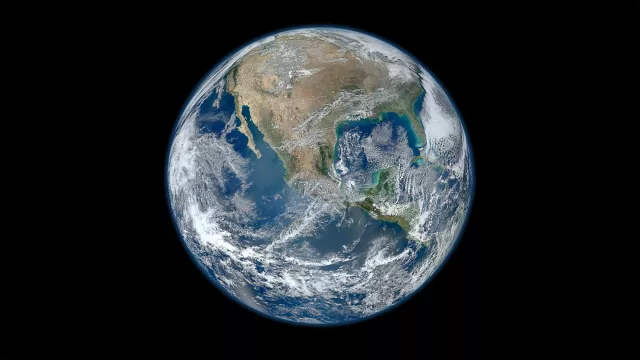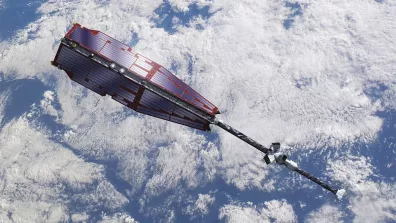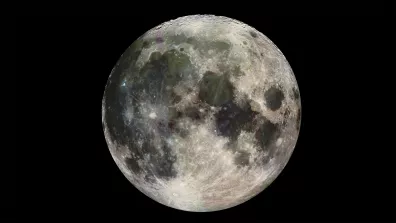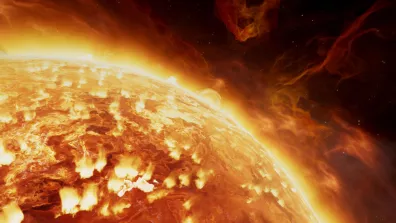Earth is the only planet in the solar system with water in its three forms—liquid, solid and gaseous—and in large amounts. And the only planet we know of to sustain life. But what exactly is this large rock like no other in the universe like?
Chiffres clés
| Distance from Sun | 149,597,870 km |
| Volume | 1.083 21 × 1012 km3 |
| Mass | 6 X 1024 kg |
| Diameter | 12,756 km |
| Gravity | Earth’s gravity (g), measured at 9.81 m/s2, is the reference value when comparing the gravity of planets |
| Axial tilt | 23.4° |
| Revolution period | 365.25 days |
| Rotation period | 23 hours, 56 minutes and 4 seconds |
| Temperature | 15°C on average at surface (but trending upwards due to global warming) |
| Moons | 1 |
A very large, very hard peach
Earth is one of the four rocky—or telluric—planets with Mercury, Venus and Mars. It’s the largest of the four, with a diameter of 12,700 kilometres. The Earth’s structure is like a peach, with a core (stone) in the middle, surrounded by a thick layer called the mantle (flesh), itself covered by a thin crust (skin).
- Core
The core is composed of a solid inner core of iron and nickel at a temperature of 6,000°C and an outer core of 89% liquid iron at around 3,500°C. This outer core works like a gigantic bicycle dynamo in which the motions of the electrically conductive liquid iron generate electrical energy, giving rise to a magnetic field.
- Mantle
The mantle is a viscous mixture of molten rock where slow creep processes carry heat from the core to the surface. Like water boiling in a saucepan, the hot currents inside the mantle are transported outwards, then cool before sinking back down through the planet’s interior. It’s this convection mechanism that drives the movement of tectonic plates at the surface.
- Crust
The crust may be oceanic, consisting of volcanic rocks and with an average thickness of six kilometres, or continental, composed of granite and 25 to 70 kilometres thick. Earth’s surface offers a range of landscapes, with volcanoes, mountains, deserts, oceans and more besides. As it has evolved, numerous and violent bombardments by meteorites, combined with erosion and tectonic plate motions have changed how it looks. And it’s still changing today, as the plates continue to move, oceans erode coastlines and certain regions dry.
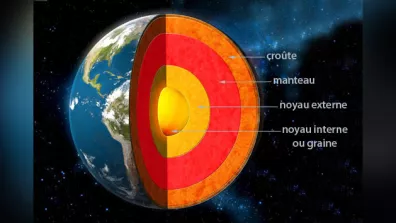
- A shielding atmosphere
Earth has an atmosphere consisting of gas shrouding the planet and held by gravity. It’s composed mainly of nitrogen (N2 78%) and oxygen (O2 21%). This atmosphere lets through some of the Sun’s rays, which heat the surface, and most of this heat is trapped by a greenhouse effect that sustains temperatures conducive to life. It also shields our planet from harmful solar radiation and meteorites.
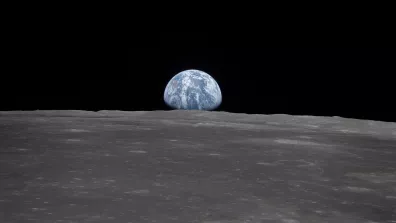
Earth laid bare
Scientists working across a wide range of disciplines are studying Earth’s size, mass, figure and internal structure from its surface, as well as from data acquired by space-based instruments.
- Studied from all angles
Earth is part of a system in which everything—land, oceans, lakes and rivers, snow and ice, the atmosphere and living organisms—is interlinked and works together. All of these elements are being studied specifically and from a global perspective. To achieve this, scientists notably use Earth-observation data acquired from space.
From space, satellites are also studying the shape and internal structure of Earth.
- Round… well, almost
Regardless of what those who still like to believe Earth is flat may say, as far back as Antiquity, scholars such as Aristotle were already advancing the idea that the Earth is a sphere. He reached this conclusion simply by watching an eclipse of the Moon: he saw that when our satellite passes in the shadow of Earth, our planet’s outline is clearly circular.

And yet… our planet isn’t quite round, as it in fact flattens at the poles. This shape of the Earth, known as the “geoid”, is due to the planet’s rotation, which generates a centrifugal force—what you experience when exiting a revolving door. This shape—or “figure”—of the Earth has been confirmed by satellites, which have even shown just how lumpy it is.
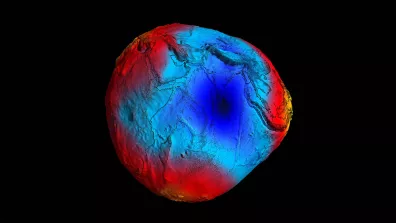
- Magnetism under close watch
Earth’s magnetic field, which protects it from harmful solar particles, is also closely studied. We know this field is generated by convection movements inside the planet’s core. The crust, oceans and the upper atmosphere also play their part. Launched in 2013, the European Space Agency’s (ESA) SWARM mission, composed of four satellites, precisely measures the intensity and direction of the magnetic fields generated by these components of our planet.

Quiz
The Earth-Sun distance has become a benchmark for astronomers. It’s known as an astronomical unit (AU): Earth orbits at a distance of 1 AU from the Sun, whereas Neptune is 30 AU from our star. But how many kilometres is 1 AU?


